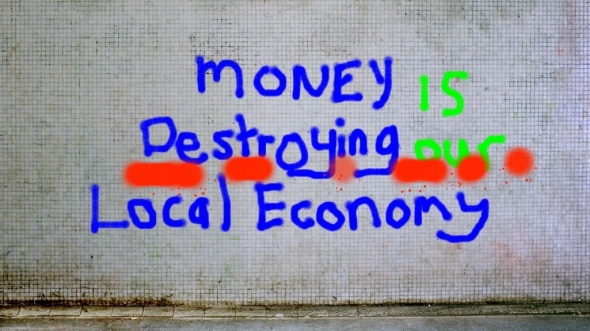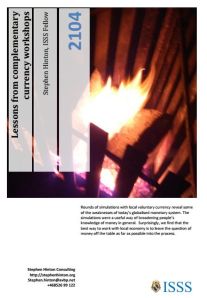Futures Forum: Relocalisation
Futures Forum: Michael Shuman and economic localisation: "Those counties with the highest density of local and small business were those that actually had the highest level of per capita income growth and were doing the best job of reducing poverty."
... and following a piece on the Resilience website:
Futures Forum: Resilience: "building a world of resilient communities"
... here is something very recent and very relevant:
It’s Money that is Killing the Local Economy

A recent report on local currency and local economy from Sweden, complied by Transition member Steve Hinton, sheds light on some of the pitfalls and opportunities for local community action. The report comes in the wake of a resilience project to create a “back-up” currency, envisioned as a preparedness tool should Sweden’s ubiquitous digital money system fail due to loss of electrical power over a longer period. Most money today in Sweden is digital, only a few percent is notes and coins. With its harsh winters and long distances, Sweden is particularly vulnerable.
The first part of the project involved creating a currency without clearing. The project, a cooperation between Transition Sweden and ISSS, the Institute of Swedish Safety and Security, revamped the German Minutos currency as a volunteer currency, covering a maximum of 400 volunteer hours per year per person.
Then Local Transition groups participated in workshops – conducted in a way resembling a fluid world café -to learn more about the currency and the possibilities to use it in local resilience projects to develop the local economy.
FIRST LEARNING: CAN YOU REALLY CREATE MONEY OUT OF NOTHING
The workshop involves making your own paper money and getting it endorsed by people who know you. Half way through cutting the notes to shape, participants would look up. a quizzical look in their eye and say “can you really create money out of nothing?”. Other participants, busily trimming their own vouchers would look up as say “why not? That’s what banks do!”
Conclusion: some basic information on the money system is needed if people are to understand how to develop their local economy.
SECOND LEARNING: I FEEL USELESS
The next step involved, just to have some “market” to try the currency out, had people creating ads for their own services. Often as not, participants would state at a blank paper and blurt out how useless they were.
Conclusion: participants and local volunteers (not all) will need easing gently into participating. Several visible wins (like planting nut trees along the streets) will raise spirits. Leadership is needed at the beginning to structure up activities so people can contribute with their skills and feel positive about what they can do.
THIRD LEARNING: SHOPPING IS FUN WHEN IT’S SUSTAINABLE
The workshop proceeds to simulate buying and selling. It’s fun. Maybe it comes from playing shops as kids or maybe it is just because it’s a human activity but creating a market and buying and selling feels good. When buying anything means that money is leaking from the local economy, well it just puts a damper on everything. Which brings us to the next learning…
FOURTH LEARNING: MONEY AS SCARCITY PUTS A DAMPER ON EVERYTHING
Reflecting over why the simulation is fun and normal buying and selling is so fraught with negative emotions, participants speculate that it has to do with a culture of scarcity; not enough atmosphere to receive carbon dioxide, not enough money to go round, not enough jobs etc.
What is good to do in the simulation is to ask people how many hours they could volunteer a year for their local Transition project. If you add all of these up, in an average size workshop, you see the equivalent of 2-3 full time staff. When you realize that together you already have, just using volunteers, the equivalent of small business staffing, you can get away from the scarcity mentality.
Conclusion: whenever running events and meetings always keep a positive atmosphere of having enough.
FIFTH LEARNING: YOU NEED ENTERPRISES
The first few times we ran the workshop we just simulated buying and selling between individuals. Something seemed to be missing. The rural development projects funded by the EU give you half of the money needed. The other half is expected to be covered by volunteer time. We introduced this into the workshop by grouping participants and asking them to design local economy development projects. They then did a “Dragons Den” investment pitch. Based on the pitch, participants “donated” money to the projects of their choice. Armed with donated cash, the projects went off looking for suitable volunteers.
This was just a simulation, but the results were always good, each project gaining enough donated hours and volunteers to have a good chance of succeeding.
Conclusion: local economies need local projects. We saw later on how several thriving local communities, with local shops, local investment companies, organic meat production, all started with volunteer projects (and some EU grant money).
SIXTH LEARNING: YOU NEED A PLACE
This might sound trite, but a sense of place is essential. Many people have very little knowledge of the place they live, and subsequently should a crisis come, they have a steep learning curve. Starting with projects that bring people together, so they get to know each other, and projects that help people get to know the place, are the foundation of a living local economy.
SEVENTH LEARNING; THE FIVE P’S OF A LOCAL ECONOMY
A resilient, local economy needs the five P’s. All of them need to be in place, and how you work with each aspect depends on the situation you are in.
PLACE: A good understanding of all aspects of the place that affect resilience: organizations, culture, ecology, infrastructure, history etc.
PEOPLE: The better people know each other and have established good relationships the better. And a good knowledge of each other’s skills and capabilities.
PROJECTS: The better the work is projectised, the faster development can move. Structured projects offer opportunities for people to engage that have difficulty structuring up and starting activities themselves.
PRODUCTS: local services, local products, the more the better. Otherwise the local economy is dependent on import and thus the money leaks out.
PAYMENT SYSTEM: A system is better than none. Sometimes local currency, or volunteer currency is ideal, others the national currency can work.
The 5P’s workshop, where participants simulate creating their own currency and creating a viable marketplace is part of the Swedish Transition movement’s Reconomy movement’s toolbox. To read the full report from the recent workshops or to order the English version of the workshop materials, visit Stephen’s website at http://stephenhinton.org
Plus a useful tool to evaluate a local currency:
No small change | new economics foundation
And a general point about the effect of 'big money' on the 'small economy':
Fact: Big-box retailers take money out of the local economy.
Because Walmart and other megachains employ primarily low-wage workers, and have huge multi-national presences, little of the money spent in your local superstore will remain in the local community. A study of the economic impact of local businesses versus large chain stores in New Orleans found that just 16 percent of money spent at the large chain remained in the local community, compared to 32 percent for independent businesses. Educate your consumers about how buying local can help your regional economy, and you may be able to sway them from switching allegiances.
Facts and Fiction About the “Walmart Effect” | Intuit Small Business Blog.
.
.




No comments:
Post a Comment